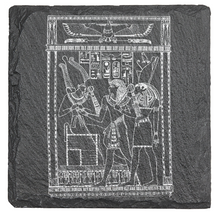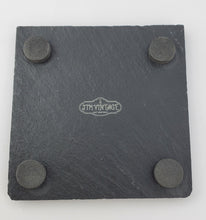Egyptian southern pharaoh engraved on fine Slate Coaster. More than a coaster, It is ART.
Own a piece of history that will last as long as Egypt itself.
"Get Inspired"  ®
®
Specifications:
The coaster measures 4X4 inches
-
History.
Why does the headdress on this image look like a bowling pin? It is known as a Hedjet. The hedjet, also known as hdt, is the crown worn by the king of Upper (Southern) Egypt. It resembles a bowling pin and is also called the “White One.” In addition, this crown is one half of the double crown, the pschent.
Here are three examples of Many Crowns of ancient Egypt.
White Crown: Hedjet
It represented Upper Egypt, and was called Hedjet; It had a truncated-conical structure, with a rounded upper end.
The material that constituted it is not known but it is possible that it was of plant origin, therefore, it would be greenish in color, although in Egyptian iconography it is represented with the white color, that of Upper Egypt. Related to the vulture goddess Nekhbet.
Red Crown: Deshret
It represented Lower Egypt, and was called Deshret, Mehes (the one from the north), or Net (similar to the goddess Neith), among other names.
It was made of the same material as the White crown, probably, as shown in the pyramid texts. Its representative color is red and it appears on the walls of the temples facing north.
Cylindrical in structure, with a curly protrusion, associated with the bee, (another symbol of the north) and with the goddess Neith. It was carried by the goddesses Wadjet, Amunet and Neith.
Double Crown: sekhemti or Pschent
It represented Upper and Lower Egypt, that is, the union of both kingdoms, the unification of Egypt. In the iconography it is represented as a White crown within the Red one. It was called by the ancient Egyptians sekhemti “the two powerful”.



